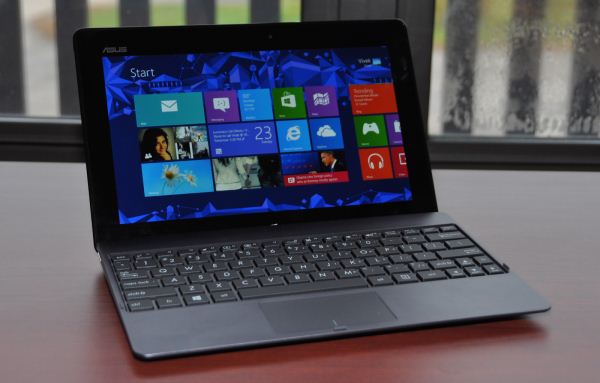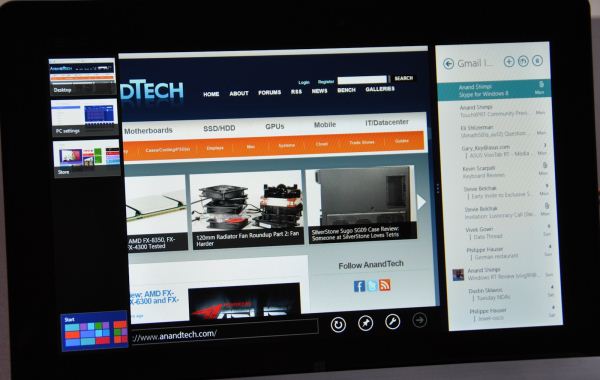The Windows RT Review
by Vivek Gowri & Anand Lal Shimpi on October 25, 2012 12:00 PM EST- Posted in
- Windows RT
- Operating Systems
- Microsoft
- Mobile
- Windows 8
- Tablets
Final Words
So, ten thousand words later, what can we take away from Windows RT? It’s definitely another superb user experience design from Microsoft. Say what you will about Windows Phone 7, but damn if that UI isn’t gorgeous. The Metro design language translates over to the tablet form factor really well, resulting in the Windows Modern UI. We’ve obviously known how Modern UI looks and feels through the various Windows 8 preview builds, but Windows RT ends up being more focused and offering a more consistent experience. It’s a side effect of being limited to apps from the Windows Store - because you spend a significant majority of your time in the new Windows UI, desktop use is minimized. In Windows RT, the Windows Desktop serves the purpose of being the more capable and powerful layer underneath the main portion of the UI, as opposed to Windows 8, which sometimes feels like the new Windows UI existing as an impractical interface layer on top of the traditional desktop.
The dichotomy just feels more comfortable in Windows RT than I feel like it has been in the previous Windows 8 systems that I’ve dealt with. It’s nice. This is the first time I feel like I’ve really connected with the new Windows UI, it makes a ton of sense to me now. I still think for mouse-based navigation, you’re better off treating it as a glorified Start menu, but it’ll be interesting to see how legacy programs affect the use of Modern UI in x86-based Windows 8 tablets as the Windows Store matures.
If you’re really concerned about the state of third-party apps, you just have to wait and see. I’ve seen a lot of snap judgements made about Windows RT in the last couple of days based on the dearth of good applications in Windows Store, and while I agree with that sentiment, I feel like it’s extremely shortsighted to write off the ecosystem already. Neither version of the OS has gone on sale yet, and we know that there are a number of applications that will go live on the official release date, as well as many more coming in the weeks ahead.
This isn’t like Windows Phone, where we need to see whether the platform will get any market traction before predicting the growth of the app marketplace. You can basically assume that the marketplace will expand significantly unless somehow everyone stops buying Windows-based systems on October 26th. The odds of that situation arising seem relatively low, so my bet is that the strength of the ecosystem will be a non-issue a month from now.
The default inclusion of Office 2013 and the emphasis on physical keyboards makes Windows RT the first tablet platform to significantly address the question of productivity. Combined with the equally advanced task switching and multitasking built into the UI, and this becomes the first legitimately useful tablet operating system out there. The Galaxy Note 10.1 wasn’t bad, but it was a single device that built additional functionality into a custom Android skin. Every single Windows RT slate comes out of the box with Office and the ability to have multiple active application windows. It’s just a few steps ahead of competing tablet platforms at this point.
And it’s not like RT loses out on a content consumption front. It’s paired with what is a very strong entertainment store and gaming franchise in Xbox Live, and the browsing experience is definitely competitive. It’s also a competent e-reader, with Amazon’s Kindle being one of the headlining apps currently in Windows Store. It even matches the power efficiency of the other ARM-based tablets, with competitive battery life and standby time. Obviously, ARM is the driving factor in the low power consumption, but it’s good to see that Windows is on a similar level as iOS and Android.
So this is a tablet platform that can do a good job of replacing both an iPad and an ultraportable in a number of different workflows. You get the best of both worlds, in some sense - Windows RT tablets have similar form factors to the iPad and leading Android tablets, and offer near-equal battery life, performance, and user experience, but they also give you the added benefit of strong productivity applications and the power of Windows Desktop. From a conceptual standpoint, almost anything you can do with an iPad can be done equally well (or close) on a Windows RT tablet, but the desktop-caliber office suite and versatile multitasking interface of Windows RT are impossible experiences to replicate on the iPad. It's not a perfect operating system by any means, but it brings a new dimension to the tablet space. So if you’re looking for a new tablet this fall, Windows RT deserves your consideration.













233 Comments
View All Comments
othercents - Thursday, October 25, 2012 - link
I really wish you could have looked closer at Live Messenger and specifically Video. My parents use Live Messenger since it is easy for them and so do most of the people I know internationally. Skype is a great application, however for them it isn't easy or familure. This is why I continue to need Live Messenger while still using Tango for most phone to phone calls. The best option would be to have Live Messenger Video available on my WP7, but it is just chat and even then some messages just don't get through.Alchemy69 - Thursday, October 25, 2012 - link
If they were going to release on OS specifically for the tablet market why bother including Metro with Windows 8 when it is so obviously geared for touchscreens?Spivonious - Thursday, October 25, 2012 - link
Honestly, the Metro UI is not that hard to use with a mouse.karasaj - Thursday, October 25, 2012 - link
I don't know why people find metro so weird - instead of having a ~90*400 or whatever pixel menu that gives you 10 programs to select, you have all your programs, and you can STILL just type away and the search function works exactly as it does in win7, you don't actually have to type anything extra.Windows key + calc + enter would still bring up the calculator, for example.
Vivek and Anand got it right imo - think of it as a glorified start menu.
ludikraut - Thursday, October 25, 2012 - link
While it's not hard, per-se, to me it feels awkward with a mouse, but just about perfect on a touch screen. IMO the icons are way too large for desktop mouse use - especially when you're used to hitting 1/4" icons on a 40" screen. :-pl8r)
Penti - Thursday, October 25, 2012 - link
You could always use a touch mouse like those from Microsoft, they are just not doing anything to promote it or it's usage scenarios i.e. gestures via mouse or trackpad. Capactive touch on a notebook-formfactor does nothing really so I don't get why they just don't turn to gestures, Apple handle that fine. With a touch mouse you can get all the Windows 8 functionality even if they assume you use fingers. Like charms, switching apps, app commands, scroll left to right and so on. But the MS Touch Mouse is also a 80 dollar device which ships with no systems.So sadly they fail to grasp how users will use these systems. Even though they do promote keyboard and multi-touch trackpad with the Surface. You really understand why major companies, component suppliers and OEM's are wary when it's an unpolished mess. I get why they try to target touch, just not why they try to just fill that space by putting an separate environment on top of the other and keeping them as separate ecosystems which are very hard to move between it's easier to port to an entirely different system which isn't an abstraction of Win32! If you don't innovate with gestures and new navigational features across the whole system it just seems stupid. You quickly get ten ways to do the same thing also. It would have made more sense if it didn't try to be Windows.
Dorek - Friday, November 2, 2012 - link
New Windows 8 machines have touchpad gestures that mirror the on-screen gestures. It's up to trackpad manufacturers to update their drivers to support gestures on older devices, but I assume many of them will.Da W - Thursday, October 25, 2012 - link
I think people underestimate the numbers of apps we're likely to see in the future. Windows phone 7 library grew to over 100000 apps despite having miserable number of units sold in the market. We will see more surface tablets and Windows 8 computers sold in the next 3 month than Windows Phone 7 ever has. The market for developper is there.Consider also the languages being supported here. You know C#, VB.net, Java, HTML5, you can do a metro app. I guess many Windows software can be recorverted to metro relatively easily. I'm not a developper, i'm just a geek and an economist, but i think Microsoft has the most developper-friendly environment out there. And many, many webservices like netflix, facebook, pulse will have a metro app down the road. Many, many iOS / Android apps are little more than rebagadged web pages after all. So you will see them on Windows 8/RT, and even more, the existance of these apps, like netflix being i think more beautiful in Metro than in a web browser, will become a reason for people to upgrade to Windows 8.
Sure the era of Microsoft monopoly over computing devices is over. But there are today some 1.3 billions PCs out there versus 100million iPads, the battle is not over by a wide margin.
That being said, i'm still waiting for my Haswell tablet with a Wacom digitizer.
Spivonious - Thursday, October 25, 2012 - link
You would want to redo the UI to work better with touch, but all of the backend code can stay exactly the same.I think we'll see the marketplace explode with Win8 apps, especially if sales continue to be good.
ludikraut - Thursday, October 25, 2012 - link
You're spot on. App development for Metro is about as easy as it gets. Much easier than IOS, IMO.Ditto for waiting on a Haswell tablet with Wacom digitizer.
l8r)